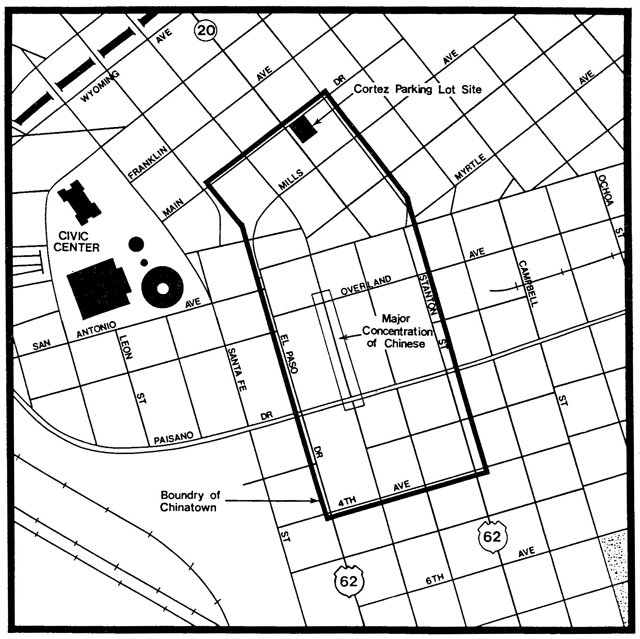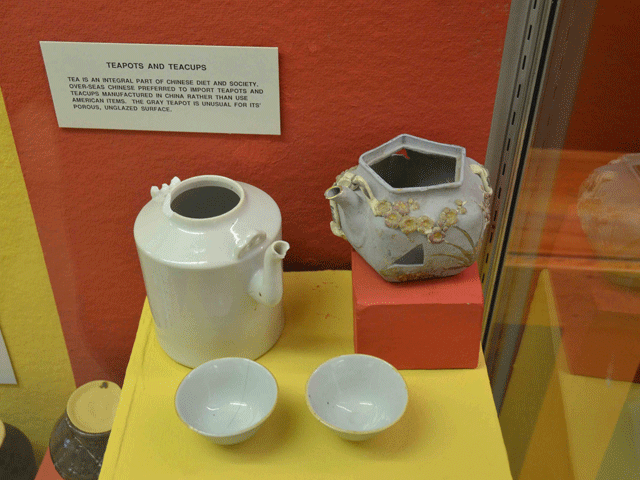
Location of El Paso's Chinatown. From a report by Dr. Edward Staski; image used by permission of the University Museum, NMSU.

Location of El Paso's Chinatown. From a report by Dr. Edward
Staski; image used by permission of the University Museum, NMSU.
The first Chinese immigrants left us few records of their daily life, and outsiders' accounts of those lives were often highly biased. An archaeological study in El Paso, just across the state line from New Mexico, combined artifacts and documents to illuminate Chinese life in the Southwest. The following information is from a report by Dr. Edward Staski, emeritus professor at New Mexico State University. reference
The early Chinese residents of El Paso were concentrated along Oregon Street. That Chinatown began when several railroads arrived in 1881–1882. The Chinese had served as railroad laborers and a few continued to hold jobs with their old employers, while others started small business. As happened throughout the West, they took on work that most Euroamericans refused to do (commercial laundry service, for example) but also ran restaurants, grocery stores, and small truck farms, or worked as waiters, cooks, or domestic servants. The last three occupations put the Chinese in direct competition for jobs with the Mexican-American community.
While in El Paso the Chinese continued to consume traditional Chinese goods, including foods, and several of the stores in El Paso's Chinatown catered to their needs. The excavations reported by Dr. Staski show that some of the food and drink consumed in the Chinatown was imported from China, in Chinese ceramic containers. These last included food jars, "wine jars" (which could contain distilled liquor), and containers for soy sauce. Imported dinnerware included dishes, rice and soup bowls, teapots and teacups (some are shown at the bottom of this page), and Chinese style spoons. At the time the Chinese glass industry had barely started, but the archaeologists found small glass medicine bottles from China. The local Chinese also purchased goods shipped in recycled U.S.-made glass bottles with Chinese labels; these probably came from places such as San Francisco. Finally, the escavations also recovered opium pipe bowls, opium tins, and Chinese coins.
The excavations indicate that from the beginning, El Paso's Chinese community was able to maintain traditional patterns of domestic consumption, including by purchasing products made in China. Even so, Dr. Staski suggests, "certain behavioral changes were occurring among ... El Paso's Chinese population by the early 20th century. It appears that some Chinese were choosing to use greater amounts of Anglo ceramics, despite the ready availability of Chinese material at that time. It appears that subtle changes in the diet were occurring, both in terms of food consumed and food production techniques."
Based on Census records, the peak documented Chinese population was 336 (in 1900), but the actual peak population may have been at least twice that. As Dr. Staski remarks, "Living conditions and social life in El Paso appear to have been similar to that experienced by other Chinese in other cities. Buildings were crowded, and sanitary conditions were poor. Only a a handful of Chinese women were ever present (a maximum of four is reported...). Most Chinese lived in a 'boarding house' situation. The non-Chinese community was hostile and unsupportive of the needs of the immigrants." For their part, few Chinese then in El Paso hoped to blend into the dominant society; their ultimate goal was to return to China.
Once the U.S. passed laws to prevent further Chinese immigration, beginning in 1882, the El Paso community served as part of an "underground railroad" that brought Chinese to the U.S. through Mexico. Even so, the El Paso Chinatown was unable to sustain itself, given its mostly bachelor status (in order to prevent the Chinese from establishing themselves in the U.S., Chinese women could not enter the country legally). Sometime in the early 1900s, El Paso's Chinatown dwindled away completely.
This page on El Paso's Chinatown was created with the help of Dr. Edward Staski, Professor Emeritus, New Mexico State University. The University Museum, NMSU granted permission to use images from Dr. Staski's report. The photographs of artifacts from the NMSU excavation were provided by the Centennial Museum at the University of Texas at El Paso, which also granted permission for their use. You can see artifacts from El Paso's Chinatown, including the ones shown below, by visiting the Centennial Museum at UTEP.

See source code for copyright information.
Page last revised on September 12, 2014.
Please report problems to toh@unm.edu